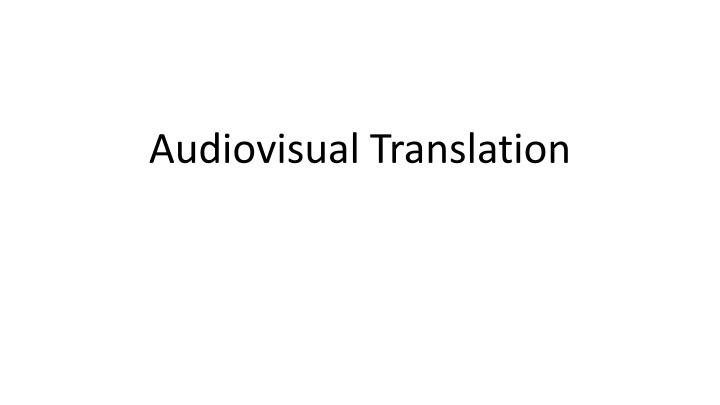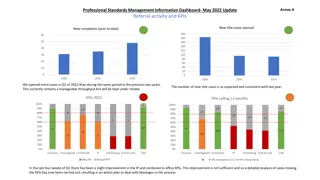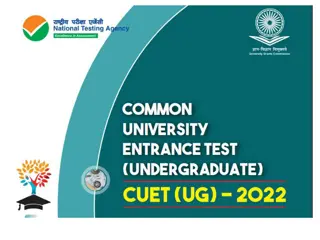
Insights into Audiovisual Translation Practices
Audiovisual translation involves transferring messages from one language to another in cinema, television, and VHS media, focusing on synchronizing verbal and nonverbal components for effective communication. Explore the historical development of audiovisual translation from the early cinema era to modern academic disciplines.
Download Presentation

Please find below an Image/Link to download the presentation.
The content on the website is provided AS IS for your information and personal use only. It may not be sold, licensed, or shared on other websites without obtaining consent from the author. If you encounter any issues during the download, it is possible that the publisher has removed the file from their server.
You are allowed to download the files provided on this website for personal or commercial use, subject to the condition that they are used lawfully. All files are the property of their respective owners.
The content on the website is provided AS IS for your information and personal use only. It may not be sold, licensed, or shared on other websites without obtaining consent from the author.
E N D
Presentation Transcript
Audiovisual Translation Audiovisual Translation Definitions: A field that encapsulates different translation practices used in the audiovisual media cinema, television, VHS (Video Home System, which is a standard for consumer-level analog video recording on tape cassettes); in this practice, there is a transfer of a message from a source to a target language, which involves some form of interaction with sounds and images. There is the consideration of audiovisual translation as the process which transforms one audiovisual text into another. Audiovisual translation is generally a translation of verbal component of the video. Its main specific feature is the synchronization of verbal and nonverbal components (Matkivska, 2014). Its main characteristic is synchronization of verbal and nonverbal components which makes translators work not only with texts but other aspects of the media art (body language, for instance). Peculiar to this type of translation is that: meaning constructed from the conjunction of images and words (sounds). From an interlinguistic perspective, audiovisual translation entails an operation on linguistic features - lines and dialogues - of an audiovisual product, to facilitate its distribution in a wider market (Fois, 2012).
Historical Glimpses of AVT Historical Glimpses of AVT The translation of cinematographical products is called audiovisual translation, though one can find many synonymous names as film translation, TV translation, screen translation and many others. From the very early years of cinema (late 1890s, early 1900s), there were people (benshis, bonimenteurs and other film explainers) whose task was to explain and comment on what was happening on the screen. In the pre-sound era, films were silent, but not speechless: mouths could be seen speaking on the screen and title cards conveyed narration and the gist of dialogues actually or seemingly spoken by the actors.
The term "silent film" is something of a misnomer, as these films were almost always accompanied by live sounds. The silent era started from the mid-1890s to the late 1920s. Nornes (2007) has identified one typical workflow as involving the shipping of a list of titles from Hollywood to the various distributors, who would translate the titles and send these flash titles back to the studio. This negatively affected the quality of the titling, e.g. when technicians without language expertise were reshooting those titles. A number of countries devised other ways of bringing sound to silent films. The early cinema of Brazil, for example, featured fitas cantatas (singing films), filmed operettas with singers performing behind the screen. In Japan, on the other hand, films had not only live music but also the benshi, a live narrator who provided commentary and character voices. The benshi became a central element in Japanese film, as well as providing translation for foreign (mostly American) movies.
AVT as an Academic Discipline AVT as an Academic Discipline: : In the twenty-first century, the media is omnipresent and its functions are to inform (arguably sometimes to misinform), to sell, to entertain and to educate. A quick reading of the traditional television programs or cinema guides will testify to the growth and importance of the media and the need for AVT in most countries. Despite being a professional practice that can be traced back to the very origins of cinema, AVT has been a relatively unknown field of research until very recently. Off to a sluggish and shaky start in the late 1950s and early 1960s, research in this field only experienced a remarkable boom at the close of the 20th century. However, over the last 30 or so years, the audiovisual industry has provided a fertile ground for a increasing activity in academic studies with translation at their core. Apart from growing as a professional activity, thanks primarily to the digital revolution, AVT has now become a resolute and prominent area of academic research. Much of the information generated by organizations nowadays is in multimedia format, be it in audio, video, animated or online format. In order to successfully communicate with as wide an audience as possible, such content must be audiovisually translated and/or localized (like games).
Reasons Why We Need AVT Diaz Cintas & Anderman (2009:1) cite a number of reason illustrating why there is a growing need for AVT: A larger number of television channels at all levels, international, national, regional and local, means a sharp increase in the quantity and range of programs required to meet the needs of broadcasting schedules; the fact that those programs need to reach viewers of different languages would unarguably require them to be audiovisually translated. The film industry seems to have emerged from the lean years when the video appeared to pose a serious threat to its continued existence, and now the number of cinema-goers again seems healthy. The flourishing celebration of film festivals, with hundreds of them taking place in any given year in all corners of the globe also testifies to this positive outlook. Add to this the advent of the DVD and the fact that the Internet is firmly established in our society and the picture is virtually complete.
There is also the theatre, the opera and other live events where translation may be required in the form of surtitles; and the rapid developments we are witnessing in the field of accessibility to the media for people with sensory impairments. Traditionally ignored in academic exchanges, subtitling for the deaf and hard-of-hearing and audio description for the blind and the partially sighted are becoming part of our daily audiovisual landscape and attracting the interest of many scholars and practitioners. With the social phenomenon of globalization, translators face the urgent need to translate films in short periods of time but in a high-quality way. Language policy. The right of linguistic and/or ethnic minorities to have access to audio-visual programs in their own language (dialect). The right of the hard-of-hearing and the deaf to have access to audio-visual programs. The role of screen translation in language acquisition or foreign language teaching.
Types (Modes) of Audiovisual Translation Dubbing: involves replacing the original soundtrack containing the actors dialogue with a target language recording that reproduces the original message, ensuring that the target language sounds and the actors lip movements are synchronized, in such a way that target viewers are led to believe that the actors on screen are actually speaking their language. Subtitling: refers to presenting a written text, usually along the bottom of the screen, which gives an account of the original dialogue exchanges of the speakers as well as other linguistic elements which form part of the visual image (inserts, letters, graffiti, banners and the like) or of the soundtrack (songs, voices off). Voiceover: is defined as reducing the volume of the original soundtrack to a minimal auditory level, in order to ensure that the translation, which is orally overlapped on to the original soundtrack, can be heard by the target audience. It is common practice to allow viewers to hear a few seconds of the original foreign speech before reducing the volume and superimposing the translation.
Types of AVT Inter-lingual AVT Subtitling Dubbing Voice over Intra-lingual subtitling for the hard-of-hearing and the deaf Audio description for the blind Live subtitling Subtitling for the opera and theater
For the Translator: For the Translator: While dealing with an audiovisual product translators do not work only with text but also with other aspects of media art which are of polyphonic nature. Thus, they work with dialogues/ comments, sound effects, image and atmosphere of the video. Gotlieb (1998) distinguishes four main channels of information which are taken into consideration while translating: 1) verbal audio channel: dialogues, off-screen voices, songs; 2) nonverbal audio channel: music, sound effects, off-screen sounds; 3) verbal and visual channel: subtitles, signs, notes, inscriptions that appear on the screen; 4) nonverbal visual channel: picture on the screen.
Software for the Audiovisual Translators: Software for the Audiovisual Translators: There are a great number of programs audiovisual translators use to carry out their job: Subtitle Edit 3.6.4 https://github.com/SubtitleEdit/subtitleedit/releases Subtitle Dawn 2.0 https://subtitle-dawn.software.informer.com/download/ AHD Subtitles Maker Professional https://ahd-subtitles-maker-professional.software.informer.com/download/ The above AVT software can be freely downloaded.
Thank You & Good Luck














